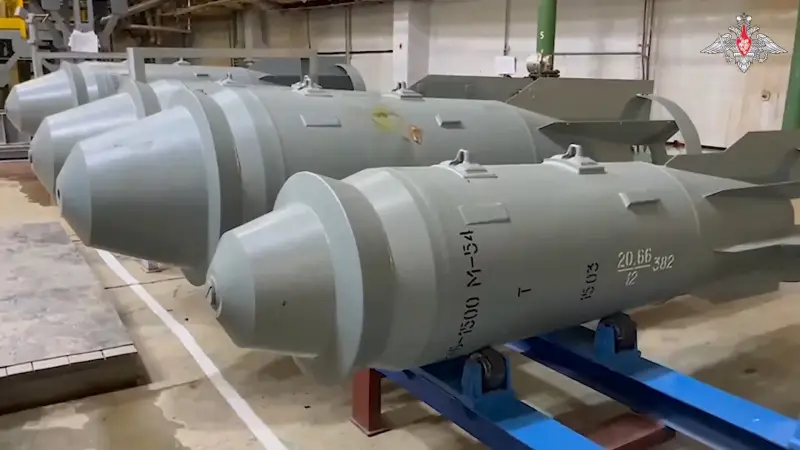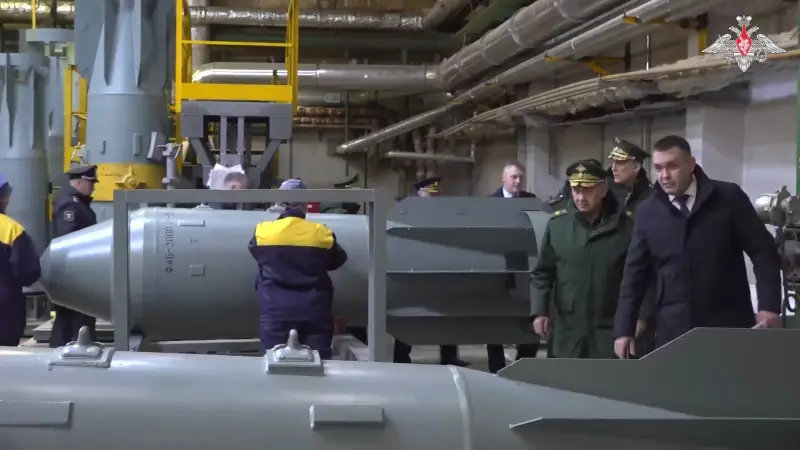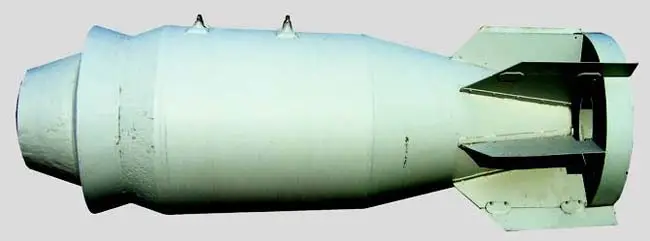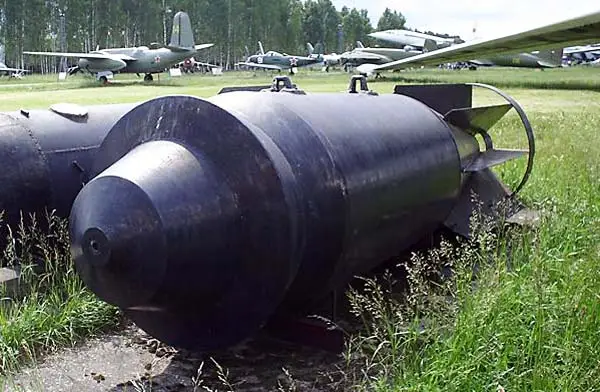Domestic large caliber aerial bombs

Production of aerial bombs. In the foreground is FAB-1500-M54, behind it is FAB-3000
There is an increased interest in the bomb armament of the Russian military aviation. Another reason for it recently became news on the resumption of production of FAB-3000 aerial bombs, which have special combat qualities. At the same time, the domestic line of heavy bombs is not limited to only a three-ton product. Larger bombs are in service and in arsenals, designed to solve the most complex combat missions.
Heavy ruler
The modern line of domestic high-explosive aircraft bombs (FAB) began to take shape in the second half of the forties. New weapons were created in parallel with promising technology and had to correspond to its tactical and technical characteristics and overall potential. First of all, it was about increasing the mass of ammunition, taking into account the increase in aircraft payload.
Using accumulated experience and new capabilities, Soviet industry developed and brought into service the FAB line in calibers from 100 to 9000 kg. Products of smaller calibers were intended for use by front-line aircraft. In turn, the larger and heavier FAB-3000, FAB-5000 and FAB-9000 bombs could only be used by long-range bombers.
Large-caliber FABs were intended to destroy large and important enemy targets. With their help, long-range aviation was supposed to destroy industrial enterprises, logistics targets, military bases, etc. In the event of a direct hit, such ammunition could destroy ground-based fortified buildings, and also ensured the defeat of manpower and infliction of other damage within a radius of tens of meters.
In the early fifties, in addition to existing FABs, a line of so-called bombs with a short body. Compared to previous products, they were marked by a reduced length and increased diameter, while the mass remained at the same level. The shortened body was equipped with a blunt-ended head fairing with a protruding anti-ricochet ring. Due to a certain deterioration in aerodynamics, such bombs were transported on an internal sling.

Defense Minister S. Shoigu at the production of large-caliber bombs. FAB-3000-M54 is being assembled
For different purposes
During the first decades, the post-war FAB line was used only as part of various exercises and demonstrated its capabilities in training grounds. In general, the bombs confirmed the calculated characteristics and showed what damage front-line and long-range aviation could inflict on the enemy.
Full combat use of the entire current FAB line began only in the eighties during the fighting in Afghanistan. Attack aircraft and front-line bombers regularly carried out sorties and used bombs of smaller calibers on enemy positions - mainly products from FAB-100 to FAB-500 were used. If necessary, heavier products were used that corresponded to the capabilities of the aircraft.
Also in Afghanistan, heavy aerial bombs in calibers from 3 tons were tested in practice. If they hit successfully, such products destroyed buildings characteristic of the region, collapsed cave vaults, caused landslides, etc. At the same time, a zone of continuous damage with a radius of only a few tens of meters imposed certain restrictions on the achievable effectiveness.
According to known data, special-power FABs were used to a limited extent during the wars in Chechnya. The widespread use of such munitions was hampered by the nature of the conflict and the small number of suitable targets. In particular, only one case of the use of FAB-9000 is known. During the First Chechen War, they tried to destroy an administrative building occupied by militants with such ammunition. The bomb was able to penetrate several floors, but did not explode.
Heavy aerial bombs have been used as part of the current Special Operation to protect Donbass. According to available data, in the spring of 2022, FAB-3000 products, along with other weapons, were used to strengthen Ukrainian formations on the territory of the Azovstal plant. As a result of regular bombings, Ukrainian nationalist militants lost the will to resist and surrendered.

General view of the product FAB-5000
It recently became known that the defense industry has resumed production of FAB-3000 aerial bombs in the 1954 version. The first batch of such products was sent to the customer in February, and new bombs are now being manufactured. Apparently, the Ministry of Defense has ordered new heavy FABs to fill arsenals, as well as for use as part of the Special Operations. We can expect that the first reports of new episodes of the use of such weapons will be received in the near future.
Technical features
Domestic high-explosive bombs are built on the basis of common technical solutions and are to a certain extent similar to each other. However, they differ in size and weight, as well as the amount of explosive. In addition, various modifications of bombs were produced, made in different housings, etc.
Air bombs of the late forties had a fairly simple design. They were made in a cylindrical body with an ogival or hemispherical head fairing and a conical tail section, on which a stabilizer with several planes was placed. Later FAB arr. 1954 are distinguished by a shorter body, formed by several conical units. They also received an anti-ricochet ring on the fairing and a new stabilizer with larger planes.
In 1962, several updated FABs in a large aspect ratio body entered service. The torpedo-shaped bomb has improved aerodynamics and is intended for use by supersonic aircraft with external sling. At the same time, the heaviest bombs, starting from the FAB-3000, did not undergo such modernization due to transportation on an internal sling.
The FAB-3000-M54 aircraft bomb - these are the products that were recently returned to series - has a total length of approx. 3,3 m with a maximum diameter of 820 mm. The total mass of the product without fuses is 3067 kg. 1387 kg of explosive is placed inside the case. Detonation is carried out using three fuses, placed in one socket in the head part and two in the tail. Detonation is provided both upon contact with the target and with a delay.

Sectional view of a five-ton bomb
The FAB-5000-M54 product also has a length of 3,3 m, but the diameter reaches 1,06 m. The mass of the bomb is 5247 kg, of which 2210 kg is the warhead. According to the principles of detonation, a five-ton bomb is no different from a three-ton one.
The largest in its family is the FAB-9000-M54 bomb. It has a length of more than 5 m and a diameter of 1,2 m. The total mass is 9407 kg with a 4,3 charge. From the point of view of layout and equipment, such a FAB is not fundamentally different from other products of its family.
FAB-3000 with a charge of approx. 1,4 tons is capable of causing serious damage. Thus, an explosion at ground level is guaranteed to kill personnel within a radius of 35-40 m. Concussions, various injuries, etc. are observed within a radius of 150-160 m. Individual fragments fly hundreds of meters away. The complete destruction zone of the FAB-9000 bomb has a radius of 55-57 m. Injuries and incapacitation of manpower are observed within 200-220 m.
Application Issues
Long-range bombers in service - Tu-3M22, Tu-3MS and Tu-95 - are considered as the main carriers of domestic aerial bombs in calibers from 160 tons. They can carry one or more bombs, depending on the type chosen, and deliver them over a long range. Large ammunition is placed in internal cargo compartments using appropriate holders.
In connection with recent news, the question arose about the possibility of using the FAB-3000 product by front-line aviation. It is assumed that the Su-34 bomber can carry at least one such bomb - on the central ventral unit or on the internal underwing ones. However, there is no confirmation of such possibilities yet.

FAB-9000 modified in 1954
The most important recent innovation in the field of bomb weapons has become the “universal planning and correction module” of the UMPC, with the help of which free-falling FABs are converted into planning guided munitions. There are UMPCs for bombs with a caliber of up to 1500 kg, and suggestions have been made about the fundamental possibility of creating a module for heavier ammunition.
UMPC for FAB-3000 or FAB-5000 in theory looks tempting and allows you to get special capabilities. However, developing a module capable of carrying such a load is a very difficult task. In addition, one can imagine what dimensions a module for a heavy bomb would have to have, and how difficult it would be to use it on modern aircraft. In general, the very possibility and feasibility of developing heavy controllable systems based on UMPC raises questions.
It should be noted that large caliber FABs are weapons for a fairly narrow niche. The bulk of combat missions are successfully accomplished with ammunition of 500-1500 kg caliber. Heavier products are needed only in certain cases, while in other situations their power will be excessive, and organizing an airstrike will be unreasonably difficult.
Opportunities
Russian combat aviation has the widest range of aircraft weapons. Air bombs occupy a prominent place in it, incl. large caliber free-falling ammunition. Each of the models in service has its own tasks and goals, and its proper use allows one to obtain the best results.
To solve particularly complex combat missions, there are high-power high-explosive bombs weighing several tons. They are not intended for regular and active use, however, even in this case they are of great importance and are kept in arsenals. Moreover, taking into account the strikes carried out and new plans, it was decided to restore the production of one of these ammunition. Time will tell where and when such bombs will be used.
Information